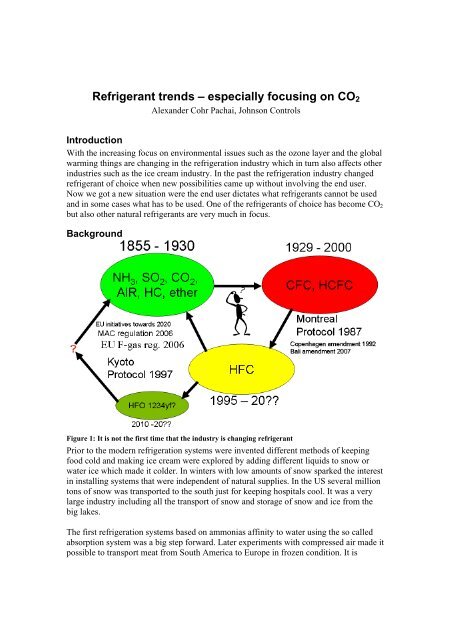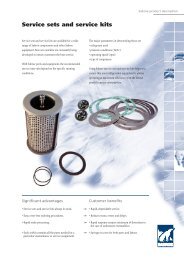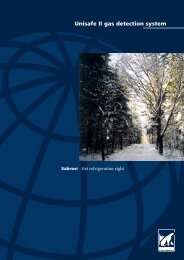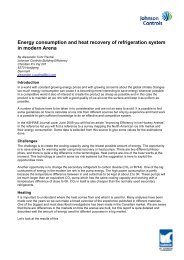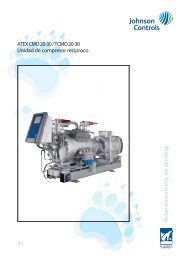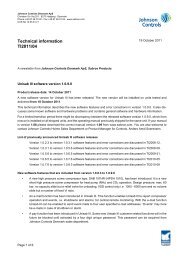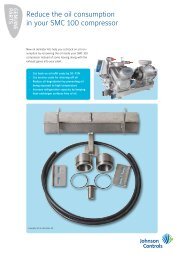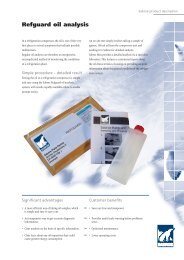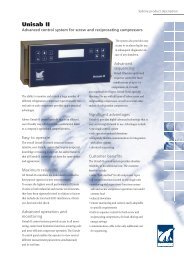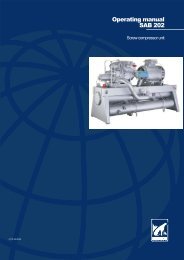here - Sabroe
here - Sabroe
here - Sabroe
- No tags were found...
You also want an ePaper? Increase the reach of your titles
YUMPU automatically turns print PDFs into web optimized ePapers that Google loves.
Refrigerant trends – especially focusing on CO 2Alexander Cohr Pachai, Johnson ControlsIntroductionWith the increasing focus on environmental issues such as the ozone layer and the globalwarming things are changing in the refrigeration industry which in turn also affects otherindustries such as the ice cream industry. In the past the refrigeration industry changedrefrigerant of choice when new possibilities came up without involving the end user.Now we got a new situation were the end user dictates what refrigerants cannot be usedand in some cases what has to be used. One of the refrigerants of choice has become CO 2but also other natural refrigerants are very much in focus.BackgroundFigure 1: It is not the first time that the industry is changing refrigerantPrior to the modern refrigeration systems were invented different methods of keepingfood cold and making ice cream were explored by adding different liquids to snow orwater ice which made it colder. In winters with low amounts of snow sparked the interestin installing systems that were independent of natural supplies. In the US several milliontons of snow was transported to the south just for keeping hospitals cool. It was a verylarge industry including all the transport of snow and storage of snow and ice from thebig lakes.The first refrigeration systems based on ammonias affinity to water using the so calledabsorption system was a big step forward. Later experiments with compressed air made itpossible to transport meat from South America to Europe in frozen condition. It is
possible obtain temperatures down to -80°C using the Joule-Thomson effect but theefficiency was not very good and the working pressures were up to 3000 bars. The highpressures caused some fatal accidents over the years the technology was used.From the middle of the 1850’s and forward the dominating technology has beencompression technology using phase changing refrigerants such as ammonia, sulphurdioxide and carbon dioxide. In the beginning of the 1920’s other natural refrigerants suchas iso-buthane, propane and ethane turned up. Most of these refrigerants disappearedrapidly after the introduction of the synthetic refrigerants sold under the trade name“Freon”. The only classical refrigerant that remained in the market was ammonia. It wasmainly used in land based industrial refrigeration systems.CO 2 disappeared from the market in the middle of the 1950’s, w<strong>here</strong> <strong>Sabroe</strong> installed thelast CO 2 system onboard a fishing vessel. The last active CO 2 systems disappeared in the1980’s. However Professor Gustav Lorentzen from Norway and others started promotingthe use of CO 2 and other natural refrigerants in the beginning of the 1990’s as a completeanswer to the environmental problems encountered with the man made green house gasessuch as the HFC’sThe Freon type refrigerants had the problem that they contained chlorine whichparticipates in the destruction of the ozone layer. Hectic diplomatic activities in the1980’s resulted the signature of the Montreal Protocol in 1987. The solution was to phaseout the CFC gases that had the strongest impact on the ozone layer. The HCFC that had alow impact on the ozone layer were then promoted as part of the solution. The phase outof the CFC gases went very quick and was relatively uncomplicated. Under a partmeeting in Copenhagen the situation changed and the HCFC’s became a part of the ozoneproblem. The phase out time for the HCFC’s was relative long because one of the mainand most popular refrigerants ever, R22, was so widely used. The last R22 refrigerationplants installed legally in Europe were installed between 2000 and 2002 depending on thesize. From the end of 2009 it is no longer legal to use virgin R22 and from the end of2014 it is also no longer to use recycled R22 to top up with in existing plants.New trendsFigure 2: Some global players are sharing knowledge aboutthe use of natural refrigerants and others do it on their own
The global players have taken position regarding which refrigerants they will use in theirsystems. Some of the big companies have gone together in different networks such as theRefrigerants Naturally initiative. Others work more independent such as Nestlé has done.In the UK the big supermarket chains have gone together under the umbrella of a tradeorganization w<strong>here</strong> they try to find a way to implement natural refrigerants in differentways.On the political scene the meeting taking place in 2009 in Copenhagen as a follow up tothe Kyoto Protocol which runs out in 2012 is attracting great interest from all parties inthe business. Will it all end up with restrictions or bans of use for the HFC refrigerants?Many players in the market do not dare to wait and see. They are acting now.Pilot project and big scale projects have been installed in a big number of countriesincluding countries that do not have to phase out R22 yet. CO 2 solutions have gained a lotof interest for freezing ice cream, bread, fish, meat and many other applications. Thetemperatures for which the systems have been used varies from room temperatures from+5°C down to -54°C which is about the limit for what you can do with CO 2 .Figure 3: An overview of some of the plants installed with Johnson Controls equipmentWhy CO 2 ?For most people it can perhaps sound strange that we suggest that you use CO 2 as arefrigerant because CO 2 by many is seen as an evil in the global warming debate. MostCO 2 used in the industry is generated as a waste product from other processes. This canbe beer production, fermentation of bread, cement production and many other processes.In some countries you can just collect it from ground sources e.g. on Iceland or in NewZealand. The energy for the production of CO 2 is t<strong>here</strong>fore only related to the cleaning ofthe gas to a refrigeration grade. This uses from ½ kWh/kg to 1/3 kWh/kg so the productiondoes not add much to the price of the gas. What increases cost is the logistic and the
documentation of the fluid. Some grades used on hospitals and for direct food contactsuch as in carbonated water or beer need very strict control and documentation. Theproduction of all other refrigerants take much more energy than the production of CO 2 torefrigerant grade.Figure 4: The production of refrigerants takes some energy, but the production of syntheticrefrigerants is much more expensive and energy intensive than production of the natural refrigerantsBecause the CO 2 is a waste product you can claim that you do the environment a favor bypostponing the release of the gas as long as it is in the refrigeration plant. The energyconsumed for the production of some refrigerants is not the only problem. Also the directeffect of some refrigerants is many times higher than for CO 2 . CO 2 is used as referencefor how powerful a green house gas each gas is. This is called the Global WarmingPotential or GWP. The GWP of R134a is 1430 meaning 1430 times higher than CO 2 .Global Warming Potential for selected refrigerants (Source: IPCC AR4)CO2NH3R600aR1270R290R134aR407CR422DR422AR417AR507R404AR220 500 1.000 1.500 2.000 2.500 3.000 3.500 4.000Figure 5: GWP values for some popular refrigerants. Some gases have a very high impact on theenvironment. The natural refrigerants have a negligible impact compared to the manmade gases.Both political smoke signals and more firm measures have been issued to make theindustry understand that it is not acceptable to use refrigeration systems with high leakGWP
ates and especially not when the refrigerants have a high impact on the environment.One good example of this it the EU directive that requires yearly or even more ofteninspection and leak test of refrigeration systems using HFC refrigerants. The bigger thecharge is the more often the inspections have to be made. At a meeting in Berlin in thespring of 2008 the German EPA minister said that if the industry did not understand themessages sent until now they will not hesitate to use other measures such as taxes and/orbans of use similar to what has been introduced already in e.g. Denmark and Austria.The signals have already been read by big players in the industry and they are t<strong>here</strong>foremoving to the use of natural refrigerants in different ways.CO 2 and safetyWhat most people do not realise is that CO 2 is as important as O 2 or oxygen forsustaining our lives. In the body we have an acid buffer with which the body maintains apH value in the brain of 7,4. This pH value is kept very rigorously steady in the hours weare awake. When we sleep the body allows this value to fluctuate a bit.In the alveolar, the smallest part of our lungs t<strong>here</strong> is a CO 2 level of 4% to 5%. In theatmosp<strong>here</strong> and the air we normally breathe the CO 2 is about 400 ppm or 0,04%. Whenwe breathe we only exhale and inhale about 1 to 1,5 litter air per breath. The total loungevolume of air is about 6 litters. This means that the CO 2 has to move from the alveolar toour throat by diffusion and the O 2 from the throat to alveolar also by diffusion. Now if theCO 2 level increases in the air we breathe the CO 2 level will increase in the alveolar andthe pH value will change in the brain within a few seconds. The body responds to thischange by increasing the breath rate. At 3% CO 2 in the air the breath rate will haveincreased to 100%. Most working persons will not realise such a increase because it iscompensated very easy by using the stomach. Most people only use about 25% of the fullpotential when breathing normally.A clear indicator of increased CO 2 levels is given by our body because it responds to theincrease also in other ways. CO 2 reacts very easily with water and forms a little carbonicacid. It gives some sting in the eyes and in the throat.From offices we also know that people get headache at CO 2 levels of 2000 ppm or 0,2%.At a little higher level you also get dizzy and uncomfortable. Normal pre-alarms are set at5.000 ppm or 0,5% and main alarm at 10.000ppm or 1%.Since CO 2 is a so integrated part of our lives it also gives clear signs when to leave theroom. As soon as we get out in fresh air we will recover fully from the exposure with inminutes and the breath rate will be back to normal. This is in fact opposite what happenswith many other gases including CFC and man made gases. The body does not react onincreased gas levels. We will just inhale until we have had to much of these gases.CO 2 also like other gases deplete oxygen and you can be suffocated but that is not specialfor CO 2 . This is often seen when people are working in wells and similar places.
Trends in the ice cream industryFigure 6: CO 2 has success fully been used in the ice cream production and is gainingmore popularityCO 2 has been introduced to the ice cream industry and the technology has been acceptedby the main companies in many countries. It has to be understood that it is not in all casesthat you can utilise the possibility of going to very low temperatures. In extruders t<strong>here</strong> isa maximum to how hard the ice cream can become without damaging the machinery. Inhardening tunnels however you can use the very cold temperatures down to about -50°C.Different applications and different machines require different temperatures.The possibilities and expectations are high for the machines using CO 2 . What is alreadyseen is a high through put on the same footprint and as footprint is a concern in manyfactories this is also an appreciated benefit of using CO 2 as a refrigerant.
Figure 7: Different applications and machines requires different temperatures (Courtesy: GramEquipment)How does it work?Normal industrial CO 2 systems are build as cascade refrigeration system. In refrigerationterms that means that one refrigeration plant cools the other plant which then cools theproduct. One essential benefit of using CO 2 in cascade with an ammonia plants is thatusing cascade systems allow us to remove ammonia from the working area. This is animportant feature for many manufacturers because ammonia is often seen as unwanted inthe work space. In the past ammonia has been widely used. In case of a leak in to theproduct area ammonia can give the product an unwanted flavour which is not the casewith CO 2 . Next thing is that ammonia in high concentrations may cause explosions or fire.Figure 8: The principle in a cascade system. The NH 3 (ammonia) system cools the CO 2system which in turn provides cooling of the product e.g. ice cream
Another benefit of the cascade system is that the ammonia charge can be very small andlimited to the machine room minimizing risk of leak that may cause problems withneighbours.Figure 9: A cascade system designed for two temperature levels. In one end two CO 2 compressorsand in the far end two NH 3 compressors.The CO 2 side works exactly like the normally used systems by circulating some liquidCO 2 in to the application. In the evaporator(s) part of the liquid is boiling and forms gaswhile the rest stays in liquid for. The mixture is returned to vessel w<strong>here</strong> liquid stays andgas is led to the compressor. The compressor compresses the gas the gas is led to thecascade heat exchanger. In the cascade heat exchanger the CO 2 gas is condensedreleasing heat to the other side w<strong>here</strong> the ammonia is evaporating and t<strong>here</strong>by absorbsheat. The liquid CO 2 is led back into the pump vessel and the process is completed. Theammonia side basically works the same way except that it is only circulating to theevaporator pumped of by the compressor and condensed by water in the condenser andback again. The short cycle gives a small charge. The water to cool the ammoniacondenser can come from a cooling tower, ground source, a nearby river or even from thesea. Finally it can be cooled by air provided the air is cold enough. Just specify what youneed and it is possible.ConclusionCO 2 is available technology and it is appreciated technology. CO 2 can help to getammonia out of production areas and be a substitute for potent green house gases oftenused in the industry.The situation is that the user of refrigeration systems has to decide who takes thedecisions: Do you take the decision of your own plants or do you wait until others do itfor you perhaps at an inconvenient time both economically and practically? The politicalworld has now been forced in to take decisions for the refrigeration system and they willdo it to look good for most voters which does not necessarily includes pleasing theindustry which in this case is pretty small.


